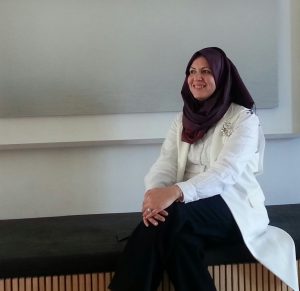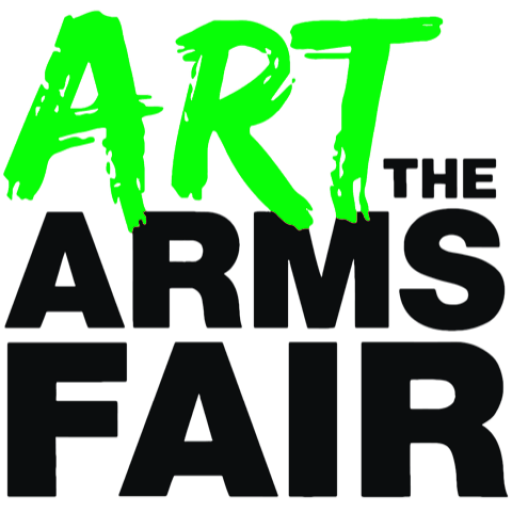Interview with Mayassah Alsader

I live in the diaspora like many Iraqis. Each city that I made into an abode draws a map in my memory. The maps collectively construct my “homeland.”
My ‘Round City’ series is inspired by the 8th century layout of Baghdad. The city was built in a circle with buildings and gardens revolving around the centre, occupied by the palace. … The first piece, entitled ‘Land of Black,’ carries a name given to my home country of Iraq because it was so lush with greenery that it would appear black from a distance.
I know that years of war have turned much of the country into ash and ruins, but by working on this painting I felt as though I was excavating the city. … Be it Baghdad, Beirut, or any other city rising from turmoil, I dream of reconstructing their built environment and hope that through my art work I contribute to the healing process of their inhabitants.
– Mayassah Alsader
Mayassah Alsader is an Iraqi British Architect, Landscape Architect and painter. She holds an MA in History of Landscape Architecture from University of Texas at Austin and a BA in Architecture. Mayassah is interested in cities and their sociopolitical environments and dedicates her artwork to depict both.
Her paintings “The Un-winged Bull” and “Field of Carnations” were sold by Bonhams auctioneer in London as part of the 3rd and 4th Konooz Fine Art Auction and Exhibition in 2017. The paintings are now part of the collection of the UAE and Iraqi embassies in London, respectively. In 2018 she was selected by Mark Borghi Fine Art for the InstaSelect group exhibition in New York City, where her painting “City of Peace” was sold. Mayassah has been part of a group of artists who exhibited their work at the “Talents Unbound” art show, which took place in Beirut in 2018.
Currently, Mayassah’s art work is featured online by The Artling. We interviewed her ahead of exhibiting her piece ‘Disarmed’ at Art the Arms Fair 2019.
1. Hi Mayassah, thank you for joining our blog interview series and for taking part in Art the Arms Fair 2019. Could you tell us a bit about you: how would you describe your work – and how did it all begin?
Hello, it is my pleasure to be part of Art the Arms Fair this year.
Art is a medium to convey a message or an idea. It is about making statement in a way that is creative, refined and civilised. If I knew that my art conveyed my message and made a difference, I would then have reached my dream.
Art led me to study Architecture and then Landscape Architecture in the first place. Later work took me and I rarely found time to invest in pure artistic work. Being a mother made it even harder to steal some of the family time, which I value most.
The opportunity came when a charity that looks after widowed women and orphans in Iraq saw my work and asked if I care to donate some of my paintings. I happily did and some of the paintings were sold through Bonhams auctioneer in London. The funds contributed to develop a centre for rehabilitation of children with Autism in Iraq. I still feel that was the best contribution I ever did. This was a real inspiration for me to revive my art path.
2. How has your focus on reconstructing cities torn apart by conflict been influenced by your identity in diaspora?
I believe this would be a natural result. I was born in Iraq and survived three wars during the ten years I lived there. I lived in several cities in the UK and USA, the Levant and North Africa. This exposed me to different cultures and built environments.
It is hard to miss the differences between the so called “civilised world ” and the “developing or third world”, parts of which have been the land of civilisations once. Through my studies of history of architecture and landscape architecture in western universities I learned about my culture of origin and valued my heritage even more than I have when I used to live in Iraq.
There is an old Arabic proverb that says “Had you not known (about some trouble), then it is a catastrophe, but had you known, then it is even more catastrophic”.
So I know first and second and third hand how war transforms cities, and the societies living in them. I feel I have to do something, and art was the medium I used to share my dream of reconstructing cities rising from turmoil and bringing back their glorious times.
3. Tell us all about the ‘Disarmed’ painting we will be displaying at Art The Arms Fair
I learned about Art The Arm Fair a couple of years ago through social media. In the meantime I was working on one of the paintings from my “Round City” series. I wanted to say something about the war in Iraq and Syria and all the mess that was happening and I have been hearing daily in the news.
My personal view is that the war in Iraq and Syria is a clear example of how arms deals can manipulate people and drive the fate of regions. From the war news and the Art The Arm Fair the “Disarmed” painting was born.
I felt that by breaking the weapons of the little plastic soldiers and by removing their combat boots, maybe I am stopping the war! I know however, it will take the courage as well the souls of many men and women to finally put an end to that war. For me, I could only document that dream of ending that war through my artwork, and I am hoping it will be conceived by other peace seekers like myself in the Art the Arm Fair exhibition.

4. Could you share something about your creative process?
I enjoy the planning and painting process as much as I long for the end result. I set a plan, but moods and settings lead me to achieve a moving target. I most value the target I reach when it is beyond my expectations.
I like to challenge the identity of the canvas, be it a soft fabric or a hard board. I vary the treatment of the different materials. For example, while acrylic is the typical paint I use, I stitch and employ threads as embroidery one time and as tying ropes another time, depending on the significance of the material.
5. What drew you to the Art the Arms Fair exhibition?
I got very excited to know about this movement that employs art to spread the message of stopping the arms deals that are costing lives and causing destruction. I decided to join and call for peace, it is my duty as a human being at the first place and as an artist second.
6. What have you experienced about the power of art, both personally and externally?
I believe that we live in the age of the image. With social media now being part of our daily lives we do not read as much as we browse images. Images create questions more than provide answers. And asking is what we need people to do more and more of in order to stop wars and arms deals. Creative works have more opportunity now to travel far and reach a bigger audience. As a person with photographic memory, strong images get stamped in my memory and they are often an inspiration for a future work.
7. Are there any artists, past or present, whose life and work have particularly inspired you?
At a young age I was taken by the work of the “old masters” but now I am particularly drawn to art works that challenge the status quo. I find works by Ai Weiwei, Mona Hatoum, Banksy and Elanatsui very interesting.
8. What projects are you currently working on, and what future plans are you envisioning?
I am now working on a new series called “War Widows” and I will continue working on the “Round City” series.
9. Favourite place?
My father’s garden.
10. Favourite read/watch of 2019?
I am reading a book by Elif Shafak called “The Architect’s Apprentice”. However my favourite book by the same author is “The Forty Rules of Love”. Lately I finished watching a Netflix series with my kids called “Blown Away”, which is about the art of glass blowing.
11. Favourite piece of art?
Mine would be “The Land of Black”. By others, it is really hard to choose but I would love to have a Rothko on my living room wall 🙂
12. What would you – in an ideal world – love to see in the news tomorrow?
How about: “The UN reached a global citizenship agreement with world leaders to lift all borders and switch weaponry budgets to development and sustainability projects.”


